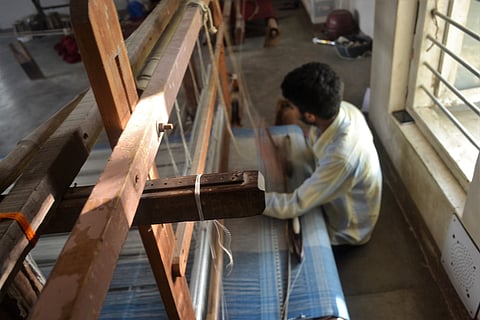
- Destinations
- Experiences
- Stay
- What's new
- Celebrating People
- Responsible Tourism
- CampaignsCampaigns
- Subscribe
- Buy Now

The environment of Kutch (sometimes spelt Kachchh) is a stark backdrop for some of India's most vibrant and bright textiles. It is also one of the country's largest hubs for crafts and textiles, with a broad yet syncretic community mix. The region is famous for the fine needlework work of nomadic tribes as well as textiles manufactured from "kala cotton," one of India's few genetically pure cotton varieties.
The Fabric We Wear
Cotton is one of the oldest non-food crops that humans have domesticated. The term "cotton" derives from the Arabic phrase al qutn, translated into algodón in Spanish and cotton in English. Although New World cotton cultivars account for practically all cotton produced globally now, older and wilder forms were grown on various continents earlier in the nineteenth century. They are known as old-world cotton, and only a handful remain today.
The Old World Kala Cotton
Kala cotton, native to Kutch, is one of the few remaining species of old-world cotton. It is a rain-fed crop with no pesticides or synthetic fertilisers. Kala Cotton is one of the few genetically pure cotton species remaining in India and one of the few pure, old-world cotton farmed today. It develops into a robust, coarse, and stretchy fibre.
The history of cotton production in India reveals evidence of various local cotton cultivars. Kala cotton (Gossypium herbaceum) is an indigenous rain-fed 'old world' cotton strain. Cotton samples discovered at the Mohenjo Daro site of Dholavira c. 2750&ndash3000 BCE indicate that the source was a plant closely similar to the Gossypium arboreum type, which was a prominent strain of local cotton in India. Farmers and weavers collaborated in Kachchh's early market systems to create rich, organic woven fabrics with a soft but durable texture.
This was the period when the British forced India to develop long-staple cotton varieties for mass production and profit. As a result, the value chain between domestic cotton producers, weavers, natural dyers, and markets was disrupted. Kala cotton output was nearly wiped off, culminating in the collapse of the homespun sector. Even after independence, despite its sturdiness and pest resistance, it was branded 'inferior' to long-staple American and other hybrid species. However, kala cotton has made an appearance in a few designer lines in recent years, creating excitement about its re-emergence.
An Ecological Fabric
This is good news because kala cotton is better for the environment and thus preferable in a world facing climate change. This is because it is rain-fed (produced without irrigation) and mostly does not require chemical fertilisers or pesticides. As a result, the ecological footprint is significantly reduced. Kala cotton is recognised as one of the most energy-efficient and carbon-neutral crops in the world.
Where You Can Find Kala Cotton
The cotton has been brought back due to the efforts of Khamir, a platform which works to strengthen and promote the rich artisanal traditions of the Kutch district.
Travel to Bhujodi in Kutch, home to weaving communities that have launched revival programmes based on locally grown and woven cotton and woollen textiles. They have made important contributions to raising awareness and demand for kala cotton goods.
Today, kala cotton is used by several designers in India, including 11.11, Rashmi Varma, and Anavila Misra, as well as brands like Sui, Earthpiece, and more.
Cover photo credit Shutterstock.com
RELATED Kutch Textiles Of Identity
